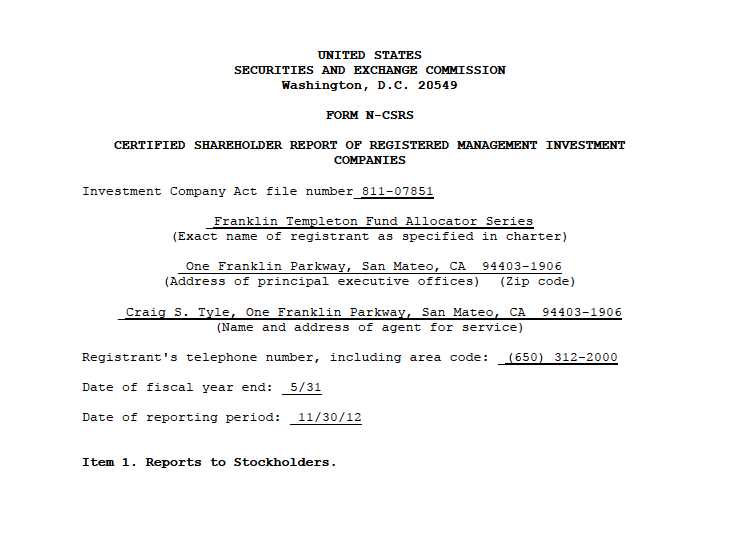NOVEMBER 30, 2012
SEMIANNUAL REPORT
AND SHAREHOLDER LETTER
A series of Franklin Templeton
Fund Allocator Series
Sign up for electronic delivery
at franklintempleton.com/edelivery

ASSET ALLOCATION
FRANKLIN TEMPLETON
MULTI-ASSET REAL RETURN FUND


| 1
Semiannual Report
Franklin Templeton Multi-Asset Real Return Fund
Your Fund’s Goal and Main Investments: Franklin Templeton Multi-Asset Real Return Fund seeks real return, which is total return that exceeds U.S. inflation over a full inflation cycle, typically five years. The Fund is structured as a limited “fund-of-funds,” meaning that it seeks to achieve its investment goal by investing its assets primarily in other mutual funds, predominantly other Franklin Templeton mutual funds (underlying funds). The Fund also invests a portion of its assets in inflation-indexed securities, predominantly Treasury Inflation-Protected Securities (TIPS).
Performance data represent past performance, which does not guarantee future results. Investment return and principal value will fluctuate, and you may have a gain or loss when you sell your shares. Current performance may differ from figures shown. Please visit franklintempleton.com or call (800) 342-5236 for most recent month-end performance.
We are pleased to bring you Franklin Templeton Multi-Asset Real Return Fund’s semiannual report for the period ended November 30, 2012.
Performance Overview
Franklin Templeton Multi-Asset Real Return Fund – Class A posted a +5.03% cumulative total return for the six months under review. The Fund outperformed the +2.19% total return of its primary benchmark, the Barclays U.S. 1-10 Year TIPS Index, which tracks performance of inflation-protected notes issued by the U.S. Treasury that have at least one year and less than 10 years to final maturity.1 The Fund also outperformed its secondary benchmark, the Consumer Price Index (CPI) for Urban Consumers (All Items) NSA (non-seasonally adjusted), a measure of the average change in prices of all goods and services purchased for consumption by urban householders, which rose 0.18% for the same period.2 The Fund underperformed the +9.32% total return of its equity benchmark, the Standard & Poor’s® 500 Index (S&P 500®), a broad measure of U.S. stock performance, but outperformed the +1.99% total return of its fixed income
1. Source: © 2012 Morningstar. All Rights Reserved. The information contained herein: (1) is proprietary to Morningstar and/or its content providers; (2) may not be copied or distributed; and (3) is not warranted to be accurate, complete or timely. Neither Morningstar nor its content providers are responsible for any damages or losses arising from any use of this information. STANDARD & POOR’S®, S&P® and S&P 500® are registered trademarks of Standard & Poor’s Financial Services LLC.
2. Source: Bureau of Labor Statistics.
The indexes are unmanaged and include reinvestment of any income or distributions. One cannot invest directly in an index, and an index is not representative of the Fund’s portfolio.
The dollar value, number of shares or principal amount, and names of all portfolio holdings are listed in the Fund’s SOI, which begins on page 17.
Semiannual Report | 3

benchmark, the Barclays U.S. Aggregate Index, which tracks U.S. investment-grade bonds.1 You can find other performance data in the Performance Summary beginning on page 8.
Economic and Market Overview
The U.S. economy grew moderately although the pace of growth slowed for most major economies during the period under review. U.S. stocks, as measured by the S&P 500, performed well. Global developed and emerging stock markets, as measured by the MSCI All Country World Index, generated robust six-month gains led by strength in Asian and European markets. Hopes for additional accommodation measures from key central banks as global inflationary pressures became relatively subdued kept equity markets buoyant through much of the third quarter despite weakened economic activity in Europe, China and various emerging markets. U.S. data offered some relief, with notable improvements in housing and labor markets and an expansion in consumer spending.
European officials addressed market concerns about the toxic link between banks and sovereign bonds by increasing the flexibility of the European Stability Mechanism, mapping out a regional banking union and vowing to do “whatever it takes” to preserve the euro. The U.S. Federal Reserve Board extended its “Operation Twist” bond-buying program in June and announced a third round of quantitative easing in September, the European Central Bank and the People’s Bank of China cut interest rates, and the Bank of England expanded its asset purchase program.
Following the U.S. presidential elections in early November, investor concerns refocused on the approaching “fiscal cliff” and its potential ramifications if automatic tax increases and federal spending cuts take effect in January 2013. In China, a transition of top political leadership coincided with rebounds in industrial output and retail sales growth, but Chinese equity markets failed to keep pace with regional peers as the new leaders agreed to leave economic policies largely unchanged.
In this environment, commodities recovered earlier losses and ended the period generally higher than six months earlier, while the euro gained against the U.S. dollar and the yen. In contrast to earlier periods of market volatility and dollar strength, the U.S. dollar fell against most major currencies during the period. Similarly, the price of the 10-year U.S. Treasury note declined, and its nominal yield ended the period at 1.62%, which trailed the 1.8% annual U.S. inflation rate.2
4 | Semiannual Report
Investment Strategy
Under normal market conditions, we allocate the Fund’s assets among the broad asset classes representing exposure to global equities, global fixed income and commodities markets by investing primarily in a combination of underlying funds, based on each underlying fund’s predominant asset class. These underlying funds, in turn, invest in a variety of U.S. and foreign equity, fixed income and money market securities, and commodity-linked instruments. We will vary the underlying funds’ allocation percentages based on the current inflationary and economic environment and our tactical views. When selecting equity funds, we consider the underlying funds’ foreign and domestic exposure, market capitalization ranges and investment style (growth vs. value). When selecting fixed income funds, we focus primarily on maximizing income. We invest in commodities funds, inflation-indexed securities, floating rate notes and inflation-sensitive equity funds in an effort to improve the portfolio’s inflation hedging properties.
With respect to the portion of the Fund’s portfolio invested in inflation-indexed securities, the investment manager subcontracts with Franklin Templeton Institutional, LLC, to manage the Fund’s assets invested in inflation-indexed securities, predominantly TIPS. Such securities are structured to provide protection against inflation. In periods shorter than a full inflation cycle, the Fund’s returns may be volatile compared with the CPI or lag behind inflation.
Manager’s Discussion
During the six months under review, near-term inflation risks remained subdued, with import prices, employment cost, producer prices and other indicators pointing toward tame inflation. We continued to monitor the threat of inflation driven by commodity prices and monetary policy, with the latter being a potentially longer term threat, in our opinion. The inflation data led us to construct a portfolio that favored domestic fixed income and foreign equity at period-end. During the period, as we became more comfortable with the potential for sustainable economic growth in the U.S. and many emerging market countries, we increased our beta stance.3 As a result, we added to our exposure in foreign equities, high yield corporate bonds and emerging market debt. We continued to be watchful of the potential global impact of the economic developments in Europe and the approaching “fiscal cliff” in the U.S., which kept us somewhat cautious during the period.
3. Beta is a measure of portfolio volatility compared to a benchmark. Generally, higher beta positioning implies the portfolio seeks to invest in securities that may result in higher relative volatility.

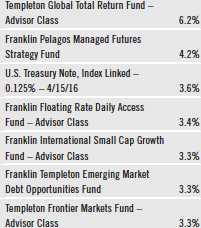
Semiannual Report | 5
From an asset class perspective, foreign equity, domestic equity, domestic fixed income, foreign fixed income, commodities and inflation-indexed securities, which at period-end comprised U.S. government and agency securities, generally supported absolute Fund performance. Within foreign equity, Franklin International Small Cap Growth Fund – Advisor Class, Templeton Foreign Fund – Advisor Class and Franklin Global Real Estate Fund – Advisor Class were top performers. Within domestic equity, Mutual Shares Fund – Class Z performed particularly well. Within domestic fixed income, Franklin Strategic Income Fund – Advisor Class and Franklin Total Return Fund – Advisor Class were notable performers. The Fund’s foreign fixed income holdings, Templeton Global Total Return Fund – Advisor Class and Franklin Templeton Emerging Market Debt Opportunities Fund, boosted returns. The Fund’s commodity holding, Franklin Pelagos Commodities Strategy Fund, also benefited Fund performance. All underlying funds held by the Fund during the reporting period delivered positive returns, with the exception of Franklin Pelagos Managed Futures Strategy Fund.
The Fund ended the period with 29.8% of total net assets in equity (13.4% domestic funds and 16.4% foreign funds), 51.2% in fixed income (23.1% domestic funds, 9.5% foreign funds and 18.6% inflation-indexed securities), 13.9% in alternative strategies (commodity and managed futures), and 5.1% in short-term investments (cash) and other net assets. With respect to inflation positioning, the Fund’s portfolio ended the period with 22.1% of total net assets in core equity funds (having a relatively high correlation to the S&P 500), 29.2% in core fixed income funds (having a relatively high correlation to the Barclays U.S. Aggregate Index), 39.4% in inflation-sensitive strategies, 4.2% in managed futures, and 5.1% in cash and other net assets. Inflation-sensitive strategies consisted of 9.7% of total net assets in commodities, 7.7% in inflation-sensitive equity funds and 22.0% in inflation-sensitive fixed income securities, specifically 18.6% in inflation-indexed securities and 3.4% in floating rate loans.
6 | Semiannual Report
Thank you for your participation in Franklin Templeton Multi-Asset Real Return Fund. We look forward to serving your future investment needs.

CFA® is a trademark owned by CFA Institute.
The foregoing information reflects our analysis, opinions and portfolio holdings as of November 30, 2012, the end of the reporting period. The way we implement our main investment strategies and the resulting portfolio holdings may change depending on factors such as market and economic conditions. These opinions may not be relied upon as investment advice or an offer for a particular security. The information is not a complete analysis of every aspect of any market, country, industry, security or the Fund. Statements of fact are from sources considered reliable, but the investment manager makes no representation or warranty as to their completeness or accuracy. Although historical performance is no guarantee of future results, these insights may help you understand our investment management philosophy.
Semiannual Report | 7
Performance Summary as of 11/30/12
Your dividend income will vary depending on dividends or interest paid by securities in the Fund’s portfolio, adjusted for operating expenses of each class. Capital gain distributions are net profits realized from the sale of portfolio securities. The performance table does not reflect any taxes that a shareholder would pay on Fund dividends, capital gain distributions, if any, or any realized gains on the sale of Fund shares. Total return reflects reinvestment of the Fund’s dividends and capital gain distributions, if any, and any unrealized gains or losses.

8 | Semiannual Report
Performance Summary (continued)
Performance1
Cumulative total return excludes sales charges. Aggregate and average annual total returns and value of $10,000 invest-ment include maximum sales charges. Class A: 5.75% maximum initial sales charge; Class C: 1% contingent deferred sales charge in first year only; Class R/Advisor Class: no sales charges.
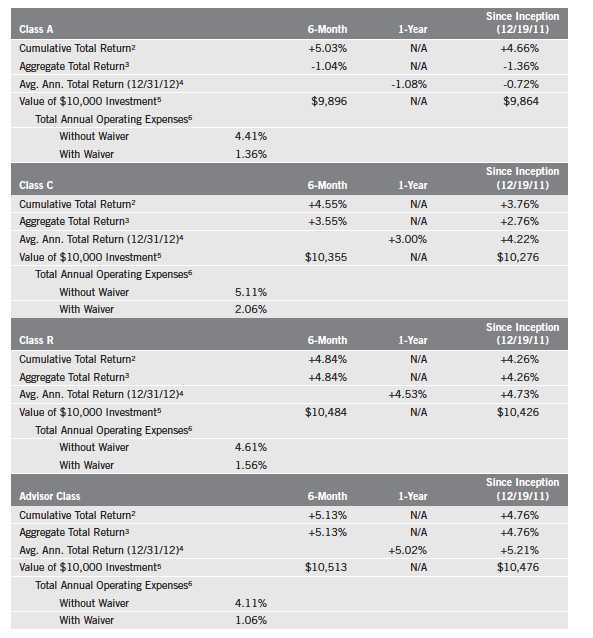
Performance data represent past performance, which does not guarantee future results. Investment return and principal value will fluctuate, and you may have a gain or loss when you sell your shares. Current performance may differ from figures shown. For most recent month-end performance, go to franklintempleton.com or call (800) 342-5236.
The investment manager has contractually agreed to waive fees or assume certain expenses so that common expenses (excluding Rule 12b-1 fees and acquired fund fees and expenses) for each class of the Fund do not exceed 0.45% (other than certain nonroutine expenses) until 9/30/13.
Semiannual Report | 9
Performance Summary (continued)
Endnotes
All investments involve risks, including possible loss of principal. Generally, investors should be comfortable with fluctuation in the value of their investments, especially over the short term. Stock prices fluctuate, sometimes rapidly and dramatically, due to factors affecting individual companies, particular industries or sectors, or general market conditions. Bond prices generally move in the opposite direction of interest rates. Thus, as the prices of bonds in the Fund adjust to a rise in interest rates, the Fund’s share price may decline. Foreign investing carries additional risks such as currency and market volatility and political or social instability, risks that are heightened in developing countries. Because the Fund has a significant investment in Treasury Inflation-Protected Securities (TIPS), it is highly influenced by the TIPS market and the monthly inflation adjustments on these securities. Commodity-linked investments can have heightened risks, including price volatility and less liquidity, and their value may be affected by the performance of broader commodities baskets and markets, as well as supply and demand, weather, and tax and other regulatory policies. Because the Fund allocates assets to a variety of investment strategies involving certain risks, the Fund may be subject to those same risks. These risks and others are described more fully in the Fund’s prospectus. The Fund is actively managed but there is no guarantee that the manager’s investment decisions will produce the desired results.

1. Fund investment results reflect the expense reduction, without which the results would have been lower. 2. Cumulative total return represents the change in value of an investment over the periods indicated.
3. Aggregate total return represents the change in value of an investment over the periods indicated. Since the Fund has existed for less than one year, average annual total returns as of 11/30/12 are not available.
4. In accordance with SEC rules, we provide standardized total return information through the latest calendar quarter. Average annual total return represents the average annual change in value of an investment over the periods indicated.
5. These figures represent the value of a hypothetical $10,000 investment in the Fund over the periods indicated.
6. Figures are as stated in the Fund’s prospectus current as of the date of this report and include the effect of acquired fund fees and expenses. In periods of market volatility, assets may decline significantly, causing total annual Fund operating expenses to become higher than the figures shown.
10 | Semiannual Report
Your Fund’s Expenses
As a Fund shareholder, you can incur two types of costs:
- Transaction costs, including sales charges (loads) on Fund purchases; and
- Ongoing Fund costs, including management fees, distribution and service (12b-1) fees, and other Fund expenses. All mutual funds have ongoing costs, sometimes referred to as operating expenses.
The following table shows ongoing costs of investing in the Fund and can help you understand these costs and compare them with those of other mutual funds. The table assumes a $1,000 investment held for the six months indicated.
Actual Fund Expenses
The first line (Actual) for each share class listed in the table provides actual account values and expenses. The “Ending Account Value” is derived from the Fund’s actual return, which includes the effect of Fund expenses.
You can estimate the expenses you paid during the period by following these steps. Of course, your account value and expenses will differ from those in this illustration:
| 1. | Divide your account value by $1,000. |
| | If an account had an $8,600 value, then $8,600 ÷ $1,000 = 8.6. |
| 2. | Multiply the result by the number under the heading “Expenses Paid During Period.” |
| | If Expenses Paid During Period were $7.50, then 8.6 x $7.50 = $64.50. |
In this illustration, the estimated expenses paid this period are $64.50.
Hypothetical Example for Comparison with Other Funds
Information in the second line (Hypothetical) for each class in the table can help you compare ongoing costs of investing in the Fund with those of other mutual funds. This information may not be used to estimate the actual ending account balance or expenses you paid during the period. The hypothetical “Ending Account Value” is based on the actual expense ratio for each class and an assumed 5% annual rate of return before expenses, which does not represent the Fund’s actual return. The figure under the heading “Expenses Paid During Period” shows the hypothetical expenses your account would have incurred under this scenario. You can compare this figure with the 5% hypothetical examples that appear in shareholder reports of other funds.
Semiannual Report | 11
Your Fund’s Expenses (continued)
Please note that expenses shown in the table are meant to highlight ongoing costs and do not reflect any transaction costs, such as sales charges. Therefore, the second line for each class is useful in comparing ongoing costs only, and will not help you compare total costs of owning different funds. In addition, if transaction costs were included, your total costs would have been higher. Please refer to the Fund prospectus for additional information on operating expenses.

*Expenses are calculated using the most recent six-month expense ratio excluding expenses of the underlying funds, net of expense waivers, annualized for each class (A: 0.57%; C: 1.45%; R: 0.95%; and Advisor: 0.45%), multiplied by the average account value over the period, multiplied by 183/365 to reflect the one-half year period.
**Expenses are calculated using the most recent six-month expense ratio including expenses of the underlying funds, net of expense waivers, annualized for each class (A: 1.25%; C: 2.13%; R: 1.63%; and Advisor: 1.13%), multiplied by the average account value over the period, multiplied by 183/365 to reflect the one-half year period.
12 | Semiannual Report
Franklin Templeton Fund Allocator Series
Financial Highlights
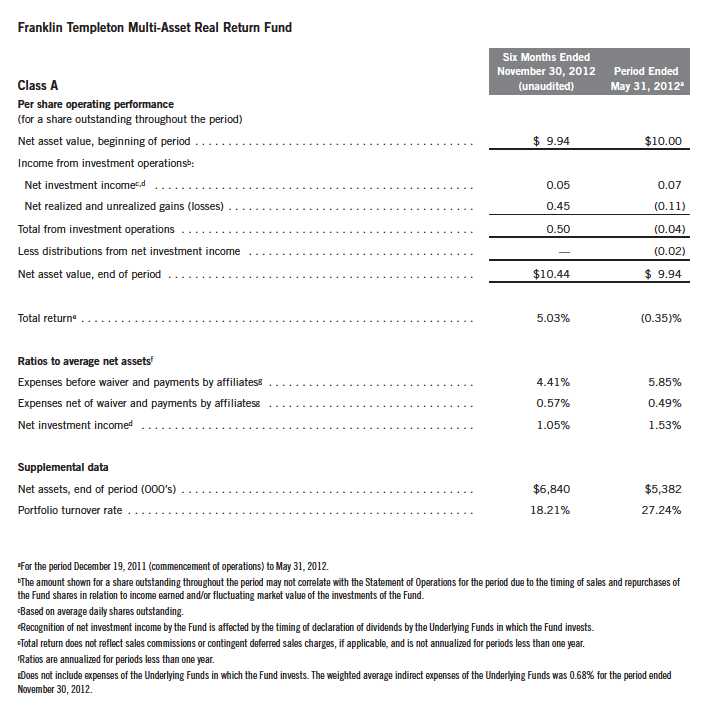
Semiannual Report | The accompanying notes are an integral part of these financial statements. | 13
Franklin Templeton Fund Allocator Series
Financial Highlights (continued)
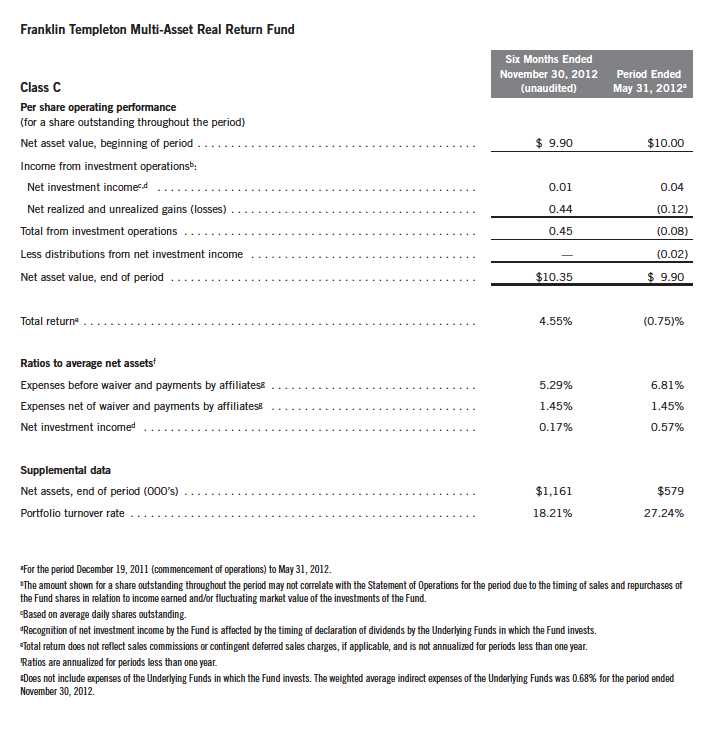
14 | The accompanying notes are an integral part of these financial statements. | Semiannual Report
Franklin Templeton Fund Allocator Series
Financial Highlights (continued)
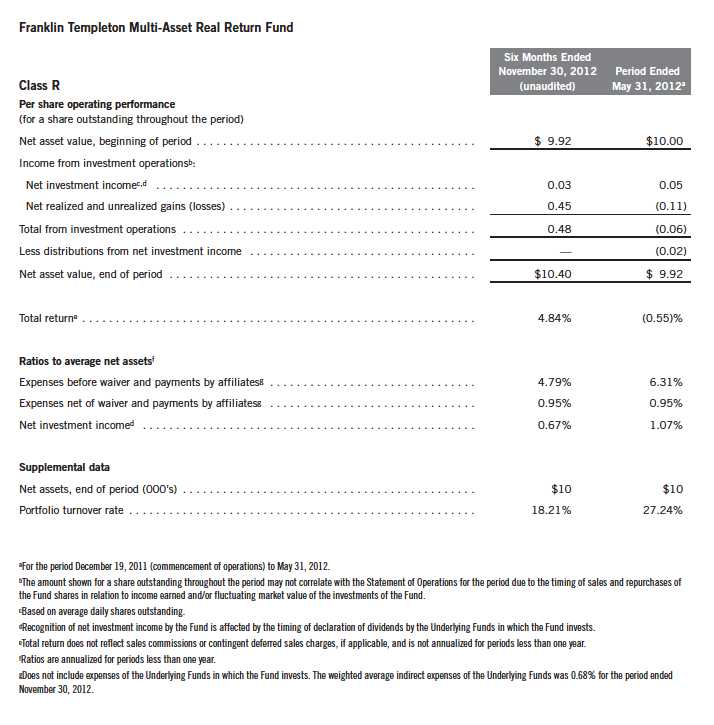
Semiannual Report | The accompanying notes are an integral part of these financial statements. | 15
Franklin Templeton Fund Allocator Series
Financial Highlights (continued)

16 | The accompanying notes are an integral part of these financial statements. | Semiannual Report
Franklin Templeton Fund Allocator Series
Statement of Investments, November 30, 2012 (unaudited)
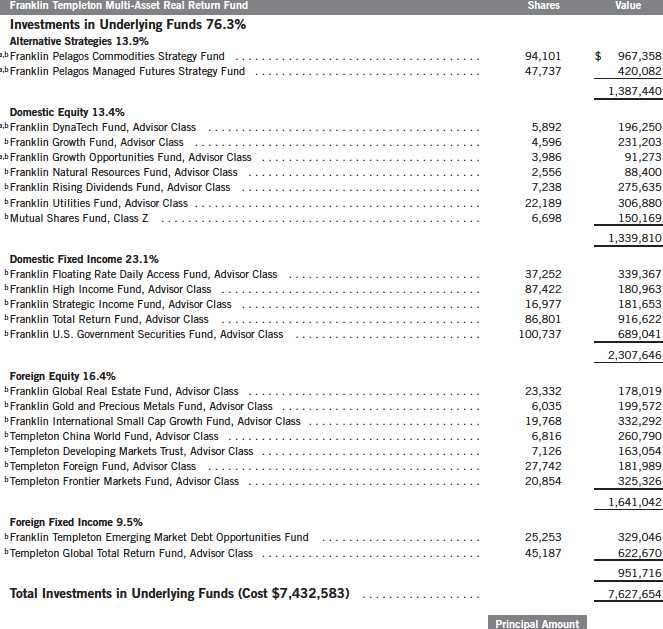


Semiannual Report | 17
Franklin Templeton Fund Allocator Series
Statement of Investments, November 30, 2012 (unaudited) (continued)
Franklin Templeton Multi-Asset Real Return Fund
Principal Amount
Value

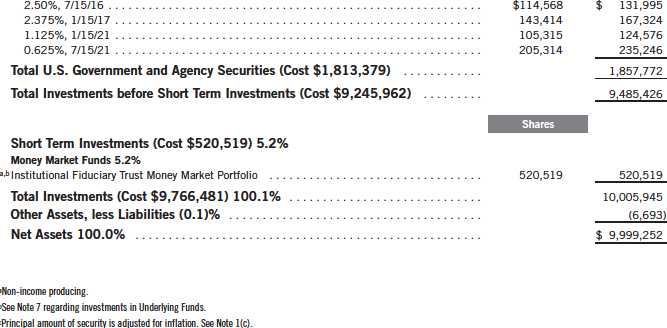
18 | The accompanying notes are an integral part of these financial statements. | Semiannual Report
Franklin Templeton Fund Allocator Series
Financial Statements
Statement of Assets and Liabilities
November 30, 2012 (unaudited)

Semiannual Report | The accompanying notes are an integral part of these financial statements. | 19
Franklin Templeton Fund Allocator Series
Financial Statements (continued)
Statement of Assets and Liabilities (continued)
November 30, 2012 (unaudited)
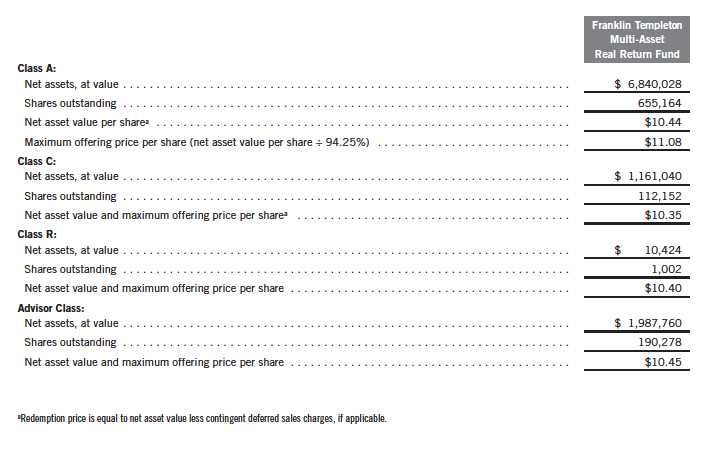
20 | The accompanying notes are an integral part of these financial statements. | Semiannual Report
Franklin Templeton Fund Allocator Series
Financial Statements (continued)
Statement of Operations
for the six months ended November 30, 2012 (unaudited)
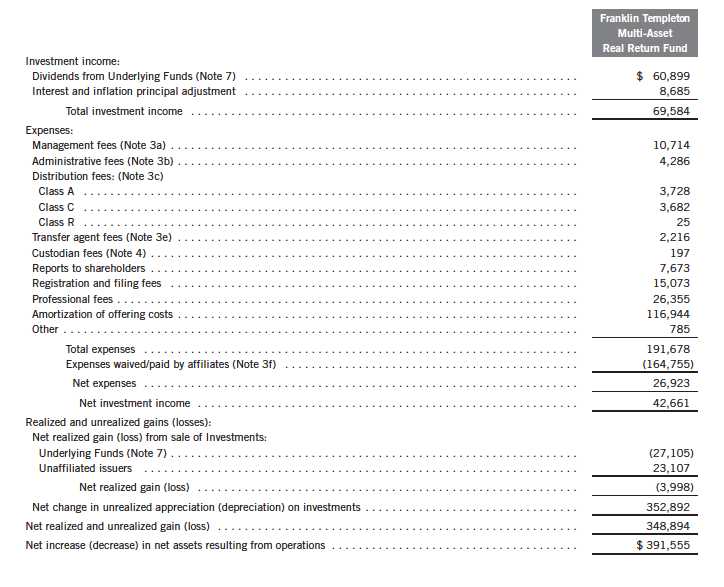
Semiannual Report | The accompanying notes are an integral part of these financial statements. | 21
Franklin Templeton Fund Allocator Series
Financial Statements (continued)

22 | The accompanying notes are an integral part of these financial statements. | Semiannual Report
Franklin Templeton Fund Allocator Series
Notes to Financial Statements (unaudited)
Franklin Templeton Multi-Asset Real Return Fund
1. ORGANIZATION AND SIGNIFICANT ACCOUNTING POLICIES
Franklin Templeton Fund Allocator Series (Trust) is registered under the Investment Company Act of 1940, as amended, (1940 Act) as an open-end investment company, consisting of ten separate funds. The Franklin Templeton Multi-Asset Real Return Fund (Fund) is included in this report. The financial statements of the remaining funds in the Trust are presented separately. The Fund invests primarily in Franklin Templeton mutual funds (Underlying Funds). The Fund offers four classes of shares: Class A, Class C, Class R, and Advisor Class. Each class of shares differs by its initial sales load, contingent deferred sales charges, distribution fees, voting rights on matters affecting a single class and its exchange privilege.
The following summarizes the Fund’s significant accounting policies.
a. Financial Instrument Valuation
The Fund’s investments in financial instruments are carried at fair value daily. Fair value is the price that would be received to sell an asset or paid to transfer a liability in an orderly transaction between market participants on the measurement date. Under procedures approved by the Trust’s Board of Trustees (the Board), the Fund’s administrator, investment manager and other affiliates have formed the Valuation and Liquidity Oversight Committee (VLOC). The VLOC provides administration and oversight of the Fund’s valuation policies and procedures, which are approved annually by the Board. Among other things, these procedures allow the Fund to utilize independent pricing services, quotations from securities and financial instrument dealers, and other market sources to determine fair value. Investments in the Underlying Funds are valued at their closing net asset value each trading day.
Debt securities generally trade in the over-the-counter market rather than on a securities exchange. The Fund’s pricing services use multiple valuation techniques to determine fair value. In instances where sufficient market activity exists, the pricing services may utilize a market-based approach through which quotes from market makers are used to determine fair value. In instances where sufficient market activity may not exist or is limited, the pricing services also utilize proprietary valuation models which may consider market characteristics such as benchmark yield curves, credit spreads, estimated default rates, anticipated market interest rate volatility, coupon rates, anticipated timing of principal repayments, underlying collateral, and other unique security features in order to estimate the relevant cash flows, which are then discounted to calculate the fair value.
The Fund has procedures to determine the fair value of financial instruments for which market prices are not reliable or readily available. Under these procedures, the VLOC convenes on a regular basis to review such financial instruments and considers a number of factors, including
Semiannual Report | 23
Franklin Templeton Fund Allocator Series
Notes to Financial Statements (unaudited) (continued)
Franklin Templeton Multi-Asset Real Return Fund
| 1. | ORGANIZATION AND SIGNIFICANT ACCOUNTING POLICIES (continued) |
| a. | Financial Instrument Valuation (continued) |
significant unobservable valuation inputs, when arriving at fair value. The VLOC primarily employs a market-based approach which may use related or comparable assets or liabilities, recent transactions, market multiples, book values, and other relevant information for the investment to determine the fair value of the investment. An income-based valuation approach may also be used in which the anticipated future cash flows of the investment are discounted to calculate fair value. Discounts may also be applied due to the nature or duration of any restrictions on the disposition of the investments. Due to the inherent uncertainty of valuations of such investments, the fair values may differ significantly from the values that would have been used had an active market existed. The VLOC employs various methods for calibrating these valuation approaches including a regular review of key inputs and assumptions, transactional back-testing or disposition analysis, and reviews of any related market activity.
b. Income Taxes
It is the Fund’s policy to qualify as a regulated investment company under the Internal Revenue Code. The Fund intends to distribute to shareholders substantially all of its taxable income and net realized gains to relieve it from federal income and excise taxes. As a result, no provision for U.S. federal income taxes is required.
The Fund recognizes the tax benefits of uncertain tax positions only when the position is “more likely than not” to be sustained upon examination by the tax authorities based on the technical merits of the tax position. As of November 30, 2012, and for all open tax years, the Fund has determined that no liability for unrecognized tax benefits is required in the Fund’s financial statements related to uncertain tax positions taken on a tax return (or expected to be taken on future tax returns). Open tax years are those that remain subject to examination and are based on each tax jurisdiction statute of limitation.
c. Security Transactions, Investment Income, Expenses and Distributions
Security transactions are accounted for on trade date. Realized gains and losses on security transactions are determined on a specific identification basis. Interest income and estimated expenses are accrued daily. Amortization of premium and accretion of discount on debt securities are included in interest income. Dividend income and realized gain distributions by Underlying Funds are recorded on the ex-dividend date. Distributions to shareholders are recorded on the ex-dividend date and are determined according to income tax regulations (tax basis). Distributable earnings determined on a tax basis may differ from earnings recorded in accordance with accounting principles generally accepted in the United States of America. These differences may be permanent or temporary. Permanent differences are reclassified among capital accounts to reflect their tax character. These reclassifications have no impact on net assets or the results of operations. Temporary differences are not reclassified, as they may reverse in subsequent periods.
24 | Semiannual Report
Franklin Templeton Fund Allocator Series
Notes to Financial Statements (unaudited) (continued)
Franklin Templeton Multi-Asset Real Return Fund
| 1. | ORGANIZATION AND SIGNIFICANT ACCOUNTING POLICIES (continued) |
| c. | Security Transactions, Investment Income, Expenses and Distributions (continued) |
Common expenses incurred by the Trust are allocated among the funds based on the ratio of net assets of each fund to the combined net assets of the Trust. Fund specific expenses are charged directly to the fund that incurred the expense.
The Funds indirectly bear their proportionate share of expenses from the Underlying Funds. Since the Underlying Funds have varied expense levels and the Funds may own different proportions of the Underlying Funds at different times, the amount of expenses incurred indirectly by the Funds will vary.
Realized and unrealized gains and losses and net investment income, not including class specific expenses, are allocated daily to each class of shares based upon the relative proportion of net assets of each class. Differences in per share distributions, by class, are generally due to differences in class specific expenses.
Inflation-indexed bonds are adjusted for inflation through periodic increases or decreases in the security’s interest accruals, face amount, or principal redemption value, by amounts corresponding to the rate of inflation as measured by an index. Any increase or decrease in the face amount or principal redemption value will be included as inflation principal adjustments on the Statement of Operations.
d. Offering Costs
Offering costs are amortized on a straight line basis over twelve months.
e. Accounting Estimates
The preparation of financial statements in accordance with accounting principles generally accepted in the United States of America requires management to make estimates and assumptions that affect the reported amounts of assets and liabilities at the date of the financial statements and the amounts of income and expenses during the reporting period. Actual results could differ from those estimates.
f. Guarantees and Indemnifications
Under the Trust’s organizational documents, its officers and trustees are indemnified by the Trust against certain liabilities arising out of the performance of their duties to the Trust. Additionally, in the normal course of business, the Trust, on behalf of the Fund, enters into contracts with service providers that contain general indemnification clauses. The Trust’s maximum exposure under these arrangements is unknown as this would involve future claims that may be made against the Trust that have not yet occurred. Currently, the Trust expects the risk of loss to be remote.
Semiannual Report | 25
Franklin Templeton Fund Allocator Series
Notes to Financial Statements (unaudited) (continued)
Franklin Templeton Multi-Asset Real Return Fund
2. SHARES OF BENEFICIAL INTEREST
At November 30, 2012, there were an unlimited number of shares authorized (without par value).
Transactions in the Fund’s shares were as follows:

3. TRANSACTIONS WITH AFFILIATES
Franklin Resources, Inc. is the holding company for various subsidiaries that together are referred to as Franklin Templeton Investments. Certain officers and trustees of the Trust are also officers and/or directors/trustees of certain of the Underlying Funds and of the following subsidiaries:

26 | Semiannual Report
Franklin Templeton Fund Allocator Series
Notes to Financial Statements (unaudited) (continued)
Franklin Templeton Multi-Asset Real Return Fund
| 3. | TRANSACTIONS WITH AFFILIATES (continued) |
| a. | Management Fees |
The Fund pays an investment management fee to Advisers of 0.25% per year of the average daily net assets of the Fund.
Under a subadvisory agreement, FT Institutional, an affiliate of Advisers, provides subadvisory services to the Fund. The subadvisory fee is paid by Advisers based on the average daily net assets, and is not an additional expense of the Fund.
b. Administrative Fees
The Fund pays an administrative fee to FT Services of 0.10% per year of the average daily net assets of the Fund.
c. Distribution Fees
The Board has adopted distribution plans for each share class, with the exception of Advisor Class shares, pursuant to Rule 12b-1 under the 1940 Act. Distribution fees are not charged on shares held by affiliates. Under the Fund’s Class A reimbursement distribution plan, the Fund reimburses Distributors for costs incurred in connection with the servicing, sale and distribution of the Fund’s shares up to the maximum annual plan rate. Under the Class A reimbursement distribution plan, costs exceeding the maximum for the current plan year cannot be reimbursed in subsequent periods. In addition, under the Fund’s Class C and R compensation distribution plans, the Fund pays Distributors for costs incurred in connection with the servicing, sale and distribution of the Fund’s shares up to the maximum annual plan rate for each class.
The maximum annual plan rates, based on the average daily net assets, for each class, are as follows:

d. Sales Charges/Underwriting Agreements
Front-end sales charges and contingent deferred sales charges (CDSC) do not represent expenses of the Fund. These charges are deducted from the proceeds of sales of Fund shares prior to investment or from redemption proceeds prior to remittance, as applicable. Distributors has advised the Fund of the following commission transactions related to the sales and redemptions of the Fund’s shares for the period:

Semiannual Report | 27
Franklin Templeton Fund Allocator Series
Notes to Financial Statements (unaudited) (continued)
Franklin Templeton Multi-Asset Real Return Fund
| 3. | TRANSACTIONS WITH AFFILIATES (continued) |
| e. | Transfer Agent Fees |
For the period ended November 30, 2012, the Fund paid transfer agent fees of $2,216, of which $1,775 was retained by Investor Services.
f. Waiver and Expense Reimbursements
Advisers and FT Services have contractually agreed in advance to waive or limit their respective fees and to assume as their own expense certain expenses otherwise payable by the Fund so that the common expenses (i.e. a combination of management fees, administrative fees, transfer agent fees, and other expenses, but excluding distribution fees and acquired fund fees and expenses) for each class of the Fund do not exceed 0.45% (other than certain non-routine expenses or costs, including those relating to litigation, indemnification, reorganizations, and liquidations) until September 30, 2013.
g. Other Affiliated Transactions
At November 30, 2012, Advisers owned 52.29% of the Fund’s outstanding shares. Investment activities of this shareholder could have a material impact on the Fund.
4. EXPENSE OFFSET ARRANGEMENT
The Fund has entered into an arrangement with its custodian whereby credits realized as a result of uninvested cash balances are used to reduce a portion of the Fund’s custodian expenses. During the period ended November 30, 2012, there were no credits earned.
5. INCOME TAXES
For tax purposes, capital losses may be carried over to offset future capital gains, if any. At May 31, 2012, the Fund had short-term capital loss carryforwards of $10,258.
At November 30, 2012, the cost of investments and net unrealized appreciation (depreciation) for income tax purposes were as follows:

Differences between income and/or capital gains as determined on a book basis and a tax basis are primarily due to differing treatments of bond discounts and premiums, offering costs, short term capital gains distributions from Underlying Funds and wash sales.
28 | Semiannual Report
Franklin Templeton Fund Allocator Series
Notes to Financial Statements (unaudited) (continued)
Franklin Templeton Multi-Asset Real Return Fund
6. INVESTMENT TRANSACTIONS
Purchases and sales of investments (excluding short term securities) for the period ended November 30, 2012, aggregated $3,447,766 and $1,502,242, respectively.
7. INVESTMENT IN UNDERLYING FUNDS
The Fund invests primarily in the Underlying Funds which are managed by Advisers or an affiliate of Advisers. The Fund does not invest in the Underlying Funds for the purpose of exercising a controlling influence over the management or policies. Management fees paid by the Fund are reduced on assets invested in the Institutional Fiduciary Trust Money Market Portfolio (Sweep Money Fund), in an amount not to exceed the management and administrative fees paid by the Sweep Money Fund.
Investments in Underlying Funds for the period ended November 30, 2012, were as follows:

Semiannual Report | 29
Franklin Templeton Fund Allocator Series
Notes to Financial Statements (unaudited) (continued)
Franklin Templeton Multi-Asset Real Return Fund
| 7. | INVESTMENT IN UNDERLYING FUNDS (continued) |

8. CREDIT FACILITY
The Fund, together with other U.S. registered and foreign investment funds (collectively, Borrowers), managed by Franklin Templeton Investments, are borrowers in a joint syndicated senior unsecured credit facility totaling $1.5 billion (Global Credit Facility) which matures on January 18, 2013. This Global Credit Facility provides a source of funds to the Borrowers for temporary and emergency purposes, including the ability to meet future unanticipated or unusually large redemption requests.
30 | Semiannual Report
Franklin Templeton Fund Allocator Series
Notes to Financial Statements (unaudited) (continued)
Franklin Templeton Multi-Asset Real Return Fund
8. CREDIT FACILITY (continued)
Under the terms of the Global Credit Facility, the Fund shall, in addition to interest charged on any borrowings made by the Fund and other costs incurred by the Fund, pay its share of fees and expenses incurred in connection with the implementation and maintenance of the Global Credit Facility, based upon its relative share of the aggregate net assets of all of the Borrowers, including an annual commitment fee of 0.08% based upon the unused portion of the Global Credit Facility, which is reflected in other expenses on the Statement of Operations. During the period ended November 30, 2012, the Fund did not use the Global Credit Facility.
9. FAIR VALUE MEASUREMENTS
The Fund follows a fair value hierarchy that distinguishes between market data obtained from independent sources (observable inputs) and the Fund’s own market assumptions (unobservable inputs). These inputs are used in determining the value of the Fund’s financial instruments and are summarized in the following fair value hierarchy:
- Level 1 – quoted prices in active markets for identical financial instruments
- Level 2 – other significant observable inputs (including quoted prices for similar financial instruments, interest rates, prepayment speed, credit risk, etc.)
- Level 3 – significant unobservable inputs (including the Fund’s own assumptions in determining the fair value of financial instruments)
The inputs or methodology used for valuing financial instruments are not an indication of the risk associated with investing in those financial instruments.
For movements between the levels within the fair value hierarchy, the Fund has adopted a policy of recognizing the transfers as of the date of the underlying event which caused the movement.
A summary of inputs used as of November 30, 2012, in valuing the Fund’s assets carried at fair value, is as follows:

Semiannual Report | 31
Franklin Templeton Fund Allocator Series
Notes to Financial Statements (unaudited) (continued)
Franklin Templeton Multi-Asset Real Return Fund
10. NEW ACCOUNTING PRONOUNCEMENTS
In December 2011, the Financial Accounting Standards Board issued Accounting Standards Update (ASU) No. 2011-11, Balance Sheet (Topic 210): Disclosures about Offsetting Assets and Liabilities. The amendments in the ASU enhance disclosures about offsetting of financial assets and liabilities to enable investors to understand the effect of these arrangements on a fund’s financial position. The ASU is effective for interim and annual reporting periods beginning on or after January 1, 2013. The Fund believes the adoption of this ASU will not have a material impact on its financial statements.
11. SUBSEQUENT EVENTS
The Fund has evaluated subsequent events through the issuance of the financial statements and determined that no events have occurred that require disclosure.
32 | Semiannual Report
Franklin Templeton Fund Allocator Series
Shareholder Information
Franklin Templeton Multi-Asset Real Return Fund
Proxy Voting Policies and Procedures
The Trust’s investment manager has established Proxy Voting Policies and Procedures (Policies) that the Trust uses to determine how to vote proxies relating to portfolio securities. Shareholders may view the Trust’s complete Policies online at franklintempleton.com. Alternatively, shareholders may request copies of the Policies free of charge by calling the Proxy Group collect at (954) 527-7678 or by sending a written request to: Franklin Templeton Companies, LLC, 300 S.E. 2nd Street, Fort Lauderdale, FL 33301, Attention: Proxy Group. Copies of the Trust’s proxy voting records are also made available online at franklintempleton.com and posted on the U.S. Securities and Exchange Commission’s website at sec.gov and reflect the most recent 12-month period ended December 31.
Quarterly Statement of Investments
The Trust files a complete statement of investments with the U.S. Securities and Exchange Commission for the first and third quarters for each fiscal year on Form N-Q. Shareholders may view the filed Form N-Q by visiting the Commission’s website at sec.gov. The filed form may also be viewed and copied at the Commission’s Public Reference Room in Washington, DC. Information regarding the operations of the Public Reference Room may be obtained by calling (800) SEC-0330.
Semiannual Report | 33
This page intentionally left blank.
This page intentionally left blank.
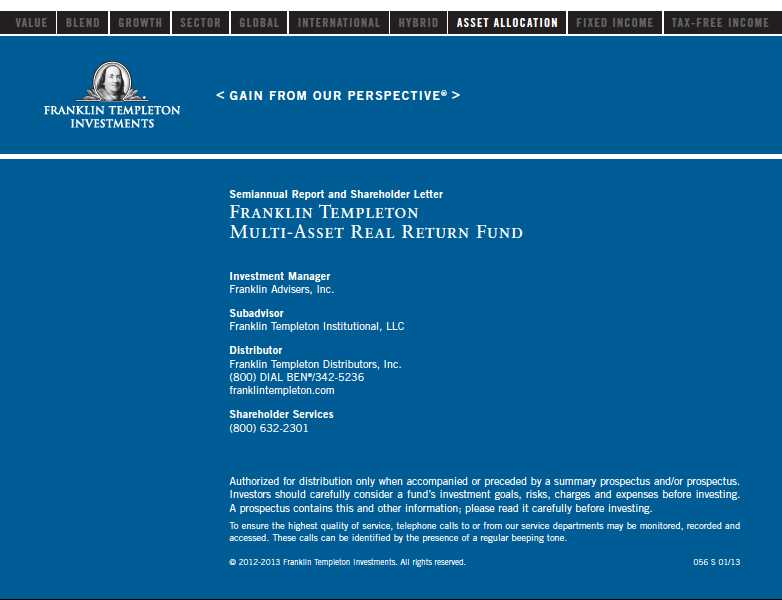
Item 2. Code of Ethics.
(a) The Registrant has adopted a code of ethics that applies to its principal executive officers and principal financial and accounting officer.
| (c) | N/A |
| (d) | N/A |
| (f) | Pursuant to Item 12(a)(1), the Registrant is attaching as an exhibit a copy of its code of ethics that applies to its principal executive officers and principal financial and accounting officer. |
Item 3. Audit Committee Financial Expert.
(a)(1) The Registrant has an audit committee financial expert serving on its audit committee.
(2) The audit committee financial expert is John B. Wilson, and he is "independent" as defined under the relevant Securities and Exchange Commission Rules and Releases.
Item 4. Principal Accountant Fees and Services. N/A
Item 5. Audit Committee of Listed Registrants. N/A
Item 6. Schedule of Investments. N/A
Item 7. Disclosure of Proxy Voting Policies and Procedures for Closed-End Management Investment Companies. N/A
Item 8. Portfolio Managers of Closed-End Management Investment Companies. N/A
Item 9. Purchases of Equity Securities by Closed-End Management Investment Company and Affiliated Purchasers. N/A
Item 10. Submission of Matters to a Vote of Security Holders.
There have been no changes to the procedures by which shareholders may recommend nominees to the Registrant's Board of Trustees that would require disclosure herein.
Item 11. Controls and Procedures.
(a) Evaluation of Disclosure Controls and Procedures. The Registrant maintains disclosure controls and procedures that are designed to ensure that information required to be disclosed in the Registrant’s filings under the Securities Exchange Act of 1934 and the Investment Company Act of 1940 is recorded, processed, summarized and reported within the periods specified in the rules and forms of the Securities and Exchange Commission. Such information is accumulated and communicated to the Registrant’s management, including its principal executive officer and principal financial officer, as appropriate, to allow timely decisions regarding required disclosure. The Registrant’s management, including the principal executive officer and the principal financial officer, recognizes that any set of controls and procedures, no matter how well designed and operated, can provide only reasonable assurance of achieving the desired control objectives.
Within 90 days prior to the filing date of this Shareholder Report on Form N-CSR, the Registrant had carried out an evaluation, under the supervision and with the participation of the Registrant’s management, including the Registrant’s principal executive officer and the Registrant’s principal financial officer, of the effectiveness of the design and operation of the Registrant’s disclosure controls and procedures. Based on such evaluation, the Registrant’s principal executive officer and principal financial officer concluded that the Registrant’s disclosure controls and procedures are effective.
(b) Changes in Internal Controls.
There have been no changes in the Registrant’s internal controls or in other factors that could materially affect the internal controls over financial reporting subsequent to the date of their evaluation in connection with the preparation of this Shareholder Report on Form N-CSR.
Item 12. Exhibits.
(a)(1) Code of Ethics
(a)(2) Certifications pursuant to Section 302 of the Sarbanes-Oxley Act of 2002 of Laura F. Fergerson, Chief Executive Officer - Finance and Administration, and Gaston Gardey, Chief Financial Officer and Chief Accounting Officer (b) Certifications pursuant to Section 906 of the Sarbanes-Oxley Act of 2002 of Laura F. Fergerson, Chief Executive Officer - Finance and Administration, and Gaston Gardey, Chief Financial Officer and Chief Accounting Officer
SIGNATURES
Pursuant to the requirements of the Securities Exchange Act of 1934 and the Investment Company Act of 1940, the registrant has duly caused this report to be signed on its behalf by the undersigned, thereunto duly authorized.
FRANKLIN TEMPLETON FUND ALLOCATOR SERIES
By /s/LAURA F. FERGERSON
Laura F. Fergerson
Chief Executive Officer - Finance and Administration
Date January 25, 2013
Pursuant to the requirements of the Securities Exchange Act of 1934 and
the Investment Company Act of 1940, this report has been signed below
by the following persons on behalf of the registrant and in the
capacities and on the dates indicated.
By /s/LAURA F. FERGERSON
Laura F. Fergerson
Chief Executive Officer - Finance and Administration
Date January 25, 2013
By /s/GASTON GARDEY
Gaston Gardey
Chief Financial Officer and Chief Accounting Officer
Date January 25, 2013
